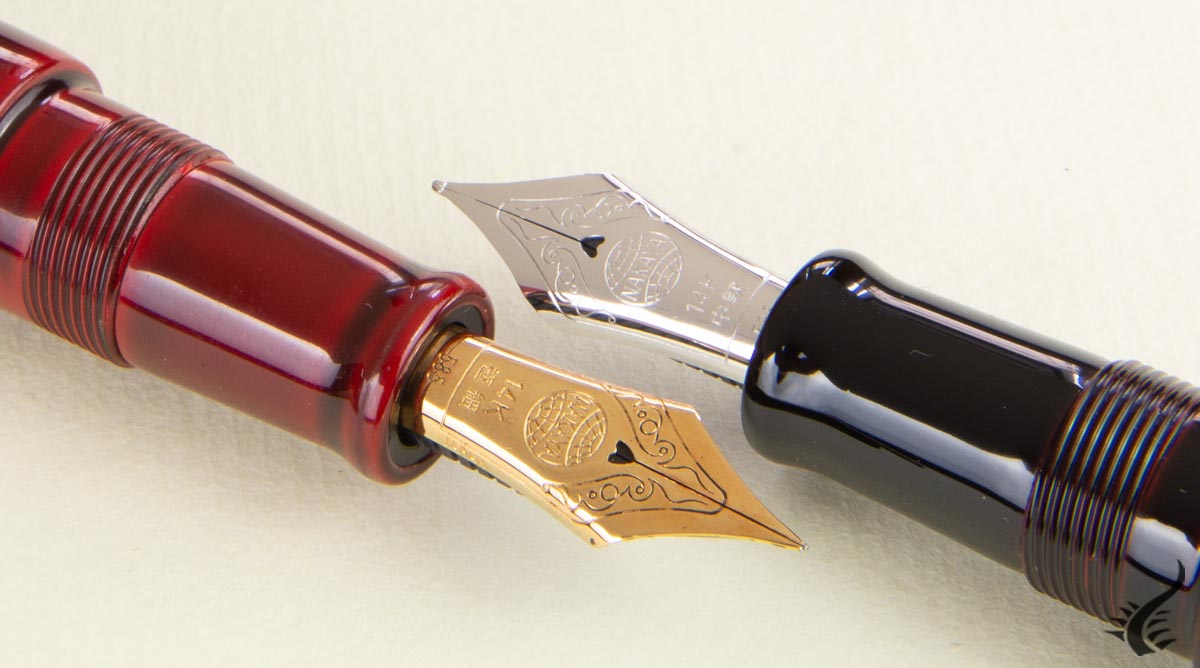Your Cart is Empty
Free shipping over £130 | THE SALE IS HERE!
Free shipping over £130 | THE SALE IS HERE!
Pens
Watches
iguana
LIGHTERS
Nakaya
October 08, 2020 5 min read

Legendary Japanese tradition
Nakaya's origin dates back to 1999, when Toshio Nakata decided to start his spectacular project. Nakata's passion for writing comes from family, as his grandfather was the founder of the well-known Platinum writing brand. At no time did Nakaya want to be the competition of his ancestors, as from the beginning Toshio Nakata was clear that he wanted to offer handmade pieces with a nib adapted to each customer. To do this, he needed master craftsmen, and so he hired Sadeo Watanabe and Kohsuke Matsubara, formerly retired Platinum workers.
After two years in the market, visiting fairs all over Japan, the brand was discovered by Russ Stutler, an American graphic artist who was fascinated by the quality of Nakaya pens. So much was his astonishment at this Japanese brand that he wrote a review on Pentrace, the international website based in Ireland and dedicated to the world of fountain pens. This fact was decisive for the brand, as from this moment on its sales began to grow exponentially. Its success was perfectly understandable, as Nakaya offered extraordinary ebonite and hand-lacquered pens with the best quality urushi. In addition, they were equipped with a solid 14-karat gold nib that was totally customized and delivered with an admirable presentation.
By 2004, after visiting many international fairs, Nakaya had already become a reference brand in the world of writing. Today, Nakaya is synonymous with quality, and the brand still maintains its original idea, but now there are four main craftsmen behind the manufacture of these wonderful pens.
The visual appeal of these pens is spectacular, so much so that each Nakaya model requires a minimum of three to six months to manufacture. The bodies of the feathers and nibs are created in Tokyo, while Urushi's lacquer work is done in the Wajima region on the west coast of Japan. Maki-e's work is done both in Wajima and in Nakaya's workshop in Tokyo.
Nakaya pens have numerous customization options and are characterized by their multiple colors, large size and original stoppers. The rainbow of possibilities it offers ranges from darker colors like Heki Tamenuri (dark brown), Aka tamenuri (maroon), Midori-Tamenuri (graphite black with green piping), Midori (dark green) to more vivid and striking colors like Shubo (deep blue), Mizu-Iro (sea green), Toki Iro (pastel pink) or Ake Tamenuri(maroon red).
Many of Nakaya's collections use the most sophisticated of all lacquer techniques, the Maki-e, offering fountain pens with different themes, such as dragons, bamboo, fish or flowers. The Maki-e will be present, sometimes, even in the converter of the piece.
Nakaya Snow Flower converter, details made with Maki-e technique
Regarding Nakaya's packaging, it is very minimalist. His pieces are presented in a white cardboard box with the appearance of rice paper, and inside you can find a very simple wooden box with inscriptions in Kanji. Inside the box you can find the pen wrapped in the charming and characteristic blue kimono of the brand, along with a small box of ink cartridges, as well as a Platinumconverter. Additionally, Nakaya also offers handmade leather cases reminiscent of Samurai sword cases.
Nakaya Writer Portable with its original unboxing, and a Nakaya leather cases with green or red details.
All Nakayamade with ebonite can also be customized through Kanji calligraphy made with the Maki-e technique. Available in four colors: silver, gold, red and blue. The usual location is usually at the end of the body, on the side opposite the nib. In Nakaya they will select the Kanji characters for you, either based on the translation, or on the phonetics of the word. In addition, in the grip section of Nakayapens, you can make an inlay called Zo-gan, applied with Maki-etechnique, something that became very popular during the golden period of Japanese pens in the 1960s.
Kanji detail in a Nakaya Long Cigar Aka Tamenuri fountain pen.
One aspect to consider with Nakayanibs is that, like most Japanese writing houses, they have a finer size classification than European fountain pens. Thus, for example, a NakayaMedium (M) is approximately equivalent to a European Fine (F). All Nakayapens can carry the size of the 14k gold nib of your choice (F, M, B, BB, FLEX M, FLEX F). The Music nib is available for an additional price, as well as the two-tone nibs, the pink gold nib, the rhodium nib or the ruthenium nib.
Nakaya's Cigar collection is characterized by the absence of the clip on the cap. Its pieces are a perfect combination of craftsmanship, design and function within a visually impressive form. They are made of different materials, such as ebonite and Urushi lacquer, thus offering pieces of exquisite quality.
To avoid the rolling of the pieces that do not have a clip, Nakaya offers a perfect complement that prevents their movement, the so-called Stoppers. They are present in a wide variety of animals and objects, becoming the perfect detail to personalize the delicate creations of this Japanese brand.
Nakaya Stopper with floral motifs
Nakaya Writer
All pens in the Writer collection feature a simple gold-plated or rhodium-plated clip, providing a perfect combination of simplicity and elegance. Within this collection we can find piccolo models, which allow a more comfortable portability.
Detail of the distinctive gold clip of the Nakaya Writer Piccolo Aka Tamenurifountain pen, and Nakaya Cigar Midori Tamenuri without clip
Nakaya Basket Mesh
In the color Indigo Blue, the piece Basket Mesh, made of a material as light as ebonite and Urushi lacquer, is extracted from a tree called "Rhus Vernicifera", better known as urushi or sumac. Its body and cap simulate the textile weave of rattan and is inspired by a model produced in 1924 by Platinum Pen under the name "Tou-amime".
Nakaya Desk
Characterized by presenting pieces with a fine and elongated shape, Desk is Nakaya's most minimalist collection. As its name indicates it is a desktop fountain pen, ideal to have on it and sign documents or write reports by hand. The design of the pens of this collection is narrowed as you reach the end of the body of the same, getting very special models for its particular shape. The pieces of this collection are very long, reaching 18 cms from the tip of the nib to the end of the body.
A curiosity of this collection is that its long thread requires four and a half turns to unscrew it from the body and put the nib into use.
The Dorsal Fin collection shows usNakaya's most distinctive models. Within this Special Edition collection there are two models: Ver. 1 and Ver.2. The first one is characterized by its cap, which has a more oval side, representing a balance between functionality and elegance. However, the second has a very characteristic shape inspired by Samurai swords. Each of the two models is available in multiple colors.
|
|
Nakaya Dorsal Fin Ver.1 Heki Tamenuri | Nakaya Dorsal Fin Ver.2 Toki-Tamenuri
The Neo Standard collection is one of the most traditional Nakaya collections... It is characterized by offering pieces more flattened at its ends.
The pieces belonging to the Raden collection are characterized by their unique and striking aesthetics, as a result of the use of abalone mother-of-pearl in their manufacture using the traditional Japanese Raden craft technique. The use of this material achieves an effect reminiscent of the Milky Way.
If you wish to know more about this magnificent Japanese fountain pen house, do not hesitate to visit our website. At Iguana Sell you will find an extensive collection of Nakaya pieces in stock that can be yours without months of waiting.
And, of course, if you require more information or wish to place an order, please do not hesitate to contact us. You can write us an email, or visit our store in Madrid, Nuñez de Balboa 90.
It will be a pleasure to help you!
Leave a comment
Comments will be approved before showing up.
Also in News
Iguana | Blog
Recent Articles
- Esterbrook: synonymous with accessibility and quality
- Luminox: adventure watches for the most extreme challenges
- Watch complications: dials that make the difference
- Madrid Pen Show 2024
- Fountain Pen Day
- Discover Zeppelin Watches: Icons of Aviation and Classic Elegance
- Montblanc Watches: From Writing to the Art of Watchmaking
- The History of Nakaya Fountain Pens: Tradition and Luxury in Every Stroke
- Luxury Watch Investments: Is It Worth It?
- Pelikan Raden M1000 Black Infinity














